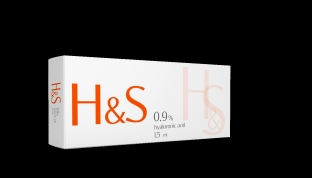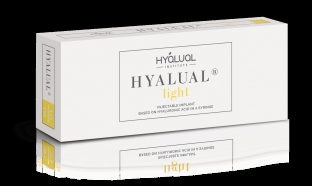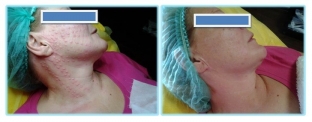Topical and systemic drugs used in the treatment of rosacea have some side effects – they dry out the skin on the face, and patients complain of itching and burning, loss of skin tone and elasticity, and the appearance of telangiectasias. For rehabilitation after treatment, the use of individually selected cosmetic procedures gives a good effect.
In this article, especially for readers, estet-portal.com shares her experience in the treatment of rosacea using redermalizants Natalia Makisha - dermatovenereologist of the highest category, cosmetologist, certified trainer Institute Hyalual. Based on her 16 years of experience as a dermatologist and 14 years of experience as a cosmetologist, she proposes to discuss cosmetic correction of rosacea using a combination of succinate and hyaluronic acid during the rehabilitation period.
Reason for Effectiveness redermalizants from Institute Hyalual for Rosacea Patients
Effectiveness of redermalizants from Institute Hyalual is due to their unique composition, which gives them an advantage over biorevitalizants, namely:
- High molecular weight (2.5 million Da) and monodispersity of hyaluronic acid with a high degree of purification, with a pronounced anti-inflammatory effect, as it activates anti-inflammatory signaling factors in the skin dermis.
- Redermalizant improves the metabolism of the extracellular matrix by supplying it with an energy substrate precursor -- succinic acid.
- Technology Double Synergic Effect, i.e. the most synergistic result of the two components – hyaluronic and succinic acids. By the way, the peculiarities of the action of succinic acid is that it, having a pronounced detoxifying effect, slows down the processes of destruction of endogenous proteins and thereby preserves the elasticity of the skin.
- PH of redermalizers is 7,4, which is as close as possible to PH of the intercellular space of healthy skin.
For the cosmetic rehabilitation of the skin of patients aged 30-35 years, in my practice I use H&S, which contains 0.9% hyaluronic acid and 1.6 mg succinate.

For cosmetic rehabilitation of the skin of patients aged 35 years and older, I use Hyalual Light with a concentration of hyaluronic acid – 1.1% and 1.6 mg succinate.

When choosing these preparations, I took into account that the use of lower concentrations of hyaluronic acid does not give the desired moisturizing effect, and the use of higher concentrations causes additional swelling of the skin, which may contribute to the formation of angiogenesis. Therefore, the choice of a drug from the line of redermalizants should be carried out individually in accordance with the clinical case of the patient.
I administer the indicated redermalizants using the classical papular technique according to the following scheme: one procedure every two weeks, the course program includes four procedures. To maintain the results obtained, I recommend repeating the courses in 3-5 months, depending on the patient's discomfort.
It is necessary to take into account that in rosacea, microcirculation is disturbed mainly along the innervation of the trigeminal nerve, and there is also dysfunction of the lymphatic system.
Clinical cases of using redermalizants from Institute Hyalual
As a result of constant long-term work with this category of patients, especially with deformative-edematous type of skin aging, I have developed a scheme for administering drugs for the first two of the four procedures, shown in the photo.
Clinical Case #1

A 38-year-old patient came to me 2 years ago with complaints of numerous purulent rashes in the face, itching, burning in the same place.
From the anamnesis: she has been sick for a year, she has repeatedly received treatment for acne with various external agents without effect.
History of life: smoking for 10 years.
When examining a patient, biliary dyskinesia of the hypomotor type, chronic gastritis associated with Helicobacter pylori, autoimmune thyroiditis.
After the diagnosis of papulo-pustular rosacea was established, taking into account the results of the examination, the patient received a full course of treatment in accordance with the protocol, after which I offered her a course of redermalization, because the patient was disturbed by a constant feeling of dryness of the skin, accompanied by a burning sensation. After treatment, a cosmetic defect remained: the skin had a thinned appearance, reduced skin tone and elasticity, multiple telangiectasias in the T-zone.
After the first redermalization procedure with Hyalual light, the patient noted a significant feeling of moisture, which had a temporary effect, so the patient underwent a full course of redermalization according to my scheme (4 procedures), and today she undergoes a course of redermalization once every three to four months, as soon as the feeling of dryness and burning of the skin of her face begins to disturb.
Clinical Case #2

A 62-year-old female patient came to me about eight years ago with complaints of pustular elements in the t-zone.
History of life: smoking since the age of thirty, early menopause at 42.
On examination: chronic calculous cholecystitis, pancreatitis, glandular hyperplasia of the thyroid gland.
After the examination, the diagnosis of papulo-pustular rosacea was made. The patient received treatment according to the protocol, but she applied for cosmetic help only three years ago, because. she was worried about severe dryness of the skin, which was not stopped by the use of moisturizing creams and serums, and the patient also complained of pronounced signs of skin aging.
I recommended her a course of redermalization with Hyalual light.
The patient completed the course according to my scheme, however, the patient noted a pronounced feeling of hydration and comfort of the skin after the third procedure. I want to note that, given the age of the patient and the duration of the disease, it is difficult to restore skin hydration. In the course of work with this patient, various preparations containing hyaluronic acid were used, but it was possible to achieve the effect of moisturizing and eliminating skin dryness, increasing its tone and elasticity, and reducing the number of teleagiectasias using Hyalual light .
Today, the patient is systematically undergoing a course of redermalization (about once every two months).
It should be noted that already after the first redermalization session, patients experience a forgotten feeling of skin hydration, which they did not achieve even after applying emollients twice during the day.
As a result, after a full course of redermalization with Institute Hyalual preparations, in almost all of my patients:
- the feeling of burning and tightness of the skin disappeared;
- visually, the severity of telangiectasias was reduced, eliminating the need for constant camouflage of facial skin;
- the effect of lifting the skin of the face appeared, and wrinkles were noticeably smoothed out after receiving effective anti-aging therapy.
Because the best reward for a cosmetologist dermatologist is the patient's beautiful and healthy skin, I hope that my experience with Institute Hyalual's redermalizers will be helpful to colleagues dealing with the manifestations of rosacea in their patients.







Add a comment